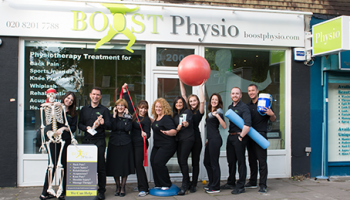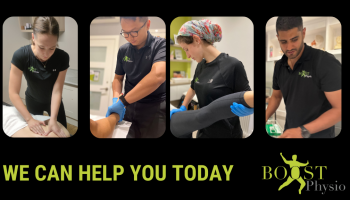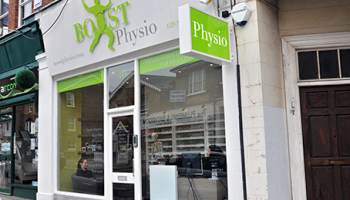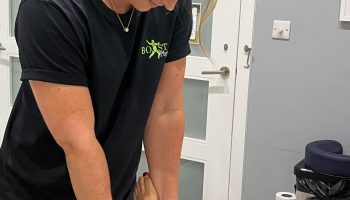Twisted or Sprained Ankle? Read on...

Ouch! Swelling and bruising after a twisted ankle indicates a Grade 2 injury which can take 6 weeks to heal.
Twisted or rolled over your ankle? OUCH! It can be very painful and swollen. What is an ankle sprain and how does
one treat it? Ankle sprains are one of the most common injuries that we treat at BOOST PHYSIO in North West London. If you have gone over on your ankle and want to know what to do, then read on. Laura Harman, Senior Physiotherapist at BOOST PHYSIO, explains the anatomy of ankle sprains and treatment including useful exercises you can do at home.
Anatomy of the ankle
The ankle is a complex structure made up of 3 different joints:
1) Talocrural joint (ankle joint)
The talocrural joint is what most people think of as the “true” ankle joint. It is made up of three bones; the tibia on the inside, the fibular on the outside and the talus underneath. This joint allow the up and down movement of the foot (dorsiflexion and plantarflexion)
2) Subtalar joint
The subtalar joint sits below the talocrural joint and is made up of the talus and the calcaneus. This joint allows the inward and outwards movement of the foot (inversion and eversion). The main role of this joint is to allow the foot to adjust to uneven ground.
3) Inferior tibiofibular joint
The inferior tibiofibular joint is the joint between the ends of the tibia and fibula. Although there is minimal movement of this joint, it is important for stability of the ankle.
In addition to the joint, there are many muscles and tendons in the ankle that allow it to move in various directions. There are also numerous ligaments that provide the foot and ankle with stability.
The main ligaments for the ankle are:
- Lateral collateral ligament – attaches the fibula to the calcaneus and provides stability to the outside of the ankle joint.
- Deltoid ligament – attaches the tibia to the talus and calcaneus and provides stability to the inside of the ankle joint.
What is an ankle sprain?
An ankle sprain is a very common injury. It can occur during sporting or everyday activities. An ankle sprain is injury to the ligaments of the ankle. Ligaments are elastic band type structures that support and stabilise joints. During normal movements the ligaments stretch to allow us to move. When a ligament is stretched too far it results in an ankle sprain. Ankle sprains are essentially overstretching or partial tearing of the ligaments. In severe cases, the ligament can completely rupture. There are different types of sprain depending on the severity of the injury:
Grade 1 – Tearing of a few ligament fibres
Grade 2 – Tearing of a considerable portion of the ligament fibres
Grade 3 – Complete tear of the ligament
Ankle sprains occur when the foot is rolled inwards or outwards, beyond it’s normal range of motion. This can happen in a number of ways, some of which are listed below:
a) Running or walking on uneven ground
b) Slipping off the edge of a curb or step
c) Jumping and landing awkwardly
d) Loosing your balance whilst wearing high heels.
The lateral ankle ligaments are much weaker than the medial deltoid ligament. As a result, inversion injuries were the foot rolls inwards are far more common that eversion injuries were the foot rolls outwards.
Treatment of ankle sprains
The most important period following an ankle sprain is within the first 48-72 hours. In this time it is important to follow the PRICE principles. PRICE helps to limit the bleeding and subsequent swelling that cause pain and joint stiffness.
Protection – Protect the ankle from further damage.
REST – Reduce activity to help decrease bleeding and swelling. This can be achieved using crutches.
ICE – Primarily used to decrease tissue metabolism in the early stages of the injury.
Compression – Decreases bleeding and therefore swelling. This is usually achieved using a compression bandage.
Elevation –helps to decrease the build up of fluid.
After the first 48-72 hours, you can begin to gradually put more weight through the ankle and start some basic ankle exercises (follow this link to view an example of early phase exercises for ankle sprains). It is important to carry out these exercises in order to prevent joint stiffness.
In order to promote the healing process of the ankle, other treatments can be used such as massage and ultrasound .
Once the pain starts to settle, it is important to strengthen the muscles surrounding the ankle before returning to any sporting activity in order to prevent future injuries.
The usual healing time for an ankle sprain is 4-6 weeks.
BOOST PHYSIO Has 2 High Street Clinics – one in Hendon NW4 and one in East Finchley N2. Call us for an appointment on 020 82017788.


Mon-Thurs 8am-9pm
Fri 8am-3pm
Sat/Sun 9am-6pm
BOOST PHYSIO works with major insurance companies like: BUPA, AVIVA, WPA, AXA. We usually deal directly with your insurance company.




















